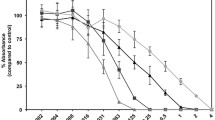Abstract
The mechanism of action of antimicrobial naphthoquinones from the fungus Fusarium was studied by using Pseudomonas aeruginosa. Bostricoidin, methyl ether fusarubin, and fusarubin stimulated the oxygen consumption of bacterial cells and induced cyanide-insensitive oxygen consumption. These activities of the tested compounds were also observed in bacterial membrane preparations in a dose-dependent manner. Naphthoquinones stimulated the generation of superoxide anion and hydrogen peroxide. The naphthoquinone effectively acted as the electron acceptors for bacterial diaphorase, which could explain the antibacterial activity of Fusarium naphthoquinones since electron acceptors lead to the stimulation of respiratory activity and the generation of oxygen radical species.
Similar content being viewed by others
Author information
Authors and Affiliations
Additional information
Received: 12 July 1996 / Accepted: 31 October 1996
Rights and permissions
About this article
Cite this article
Haraguchi, H., Yokoyama, K., Oike, S. et al. Respiratory stimulation and generation of superoxide radicals in Pseudomonas aeruginosa by fungal naphthoquinones. Arch Microbiol 167, 6–10 (1997). https://doi.org/10.1007/s002030050409
Issue Date:
DOI: https://doi.org/10.1007/s002030050409




